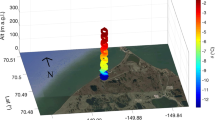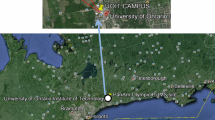Abstract
We present unique observations of a total solar eclipse from a small unmanned aircraft system (sUAS) platform that was operated during the 21 August 2017 North American solar eclipse. The observations were collected near Ten Mile, Tennessee, where eclipse totality lasted 2 min 38 s. A 2-m micrometeorological tripod was erected on-site to measure surface and air temperature, near-surface water vapour, incoming and outgoing shortwave and longwave radiative fluxes, and turbulent fluxes. The sUAS platform and micrometeorological tripod observations indicate significant cooling below a height of 50 m above ground level (a.g.l.) during and shortly after totality. Near-surface temperatures do not return to pre-eclipse values until about 60 min following totality. Above about 50 m a.g.l., smaller temperature changes are observed during the eclipse, as the duration of the eclipse has less influence on deeper boundary-layer turbulence. Additionally, the sensible heat flux becomes slightly negative around totality, and the turbulence kinetic energy and vertical velocity variance concurrently decrease. The evolution of the near-surface meteorological fields are investigated in more detail using a large-eddy simulation (LES) model. The simulations generally reproduce the observations well, in terms of the timing and magnitude of changes in temperature, moisture and sensible and latent heat fluxes. However, the LES model slightly underestimates the diurnal range and decrease in temperature during the eclipse while overestimating the sensible heat fluxes.













Similar content being viewed by others
References
Anderson J (1999) Meteorological changes during a solar eclipse. Weather 54:207–215
Anderson RC, Keefer DR (1975) Observations of the temperature and pressure changes during the 30 June 1973 solar eclipse. J Atmos Sci 32:228–231
Anderson RC, Keefer DR, Myers OE (1972) Atmospheric pressure and temperature changes during the 7 March 1970 Solar eclipse. J Atmos Sci 29:583–587
Buban MS, Ziegler CL, Mansell ER, Richardson YP (2012) Simulation of dryline misovortex dynamics and cumulus formation. Mon Weather Rev 140:3525–3551
Coniglio MC, Stensrud DJ, Wicker LJ (2006) Effects of upper-level shear on the structure and maintenance of strong quasi-linear mesoscale convective systems. J Atmos Sci 63:1231–1252
Deardorff JW (1978) Efficient prediction of ground surface temperature and moisture, with inclusion of a layer of vegetation. J Geophys Res 83:1889–1903
Dumas EJ., Lee TR, Buban MS, Baker CB (2016) Small unmanned aircraft system (sUAS) measurements during the 2016 verifications of the origins of rotation in tornadoes experiment southeast (VORTEX-SE). NOAA technical memorandum OAR ARL-273. https://doi.org/10.7289/v5/tm-oar-arl-273
Eaton FD, Hines JR, Hatch WH, Cionco RM, Byers J, Garvey D, Miller DR (1997) Solar eclipse effects observed in the planetary boundary layer over a desert. Boundary-Layer Meteorol 83:331–346
Foken TB, Wichura Klemm O, Gerchau J, Winterhalter M, Weidinger T (2001) Micrometeorological measurements during the total solar eclipse of August 11, 1999. Meteorol Z 10:171–178
Founda DD, Melas Lykoudis S, Lisardis I, Gerasopoulos E, Kouvarakis G, Petrakis M, Zerefos C (2007) The effect of the total solar eclipse of 29 March 2006 on meteorological variables in Greece. Atmos Chem Phys 7:5543–5553
Krishnan PP, Kunhikrishnan K, Muraleedharan S, Nair Ravindran S, Ramachandran R, Subrahamanyam DB, Venkata Ramana M (2004) Observations of the atmospheric surface layer parameters over a semi arid region during the solar eclipse of August 11th 1999. Proc Indian Acad Sci 113:353–363
Lee TR, Buban MS, Dumas E, Baker CB (2017) A new technique to estimate sensible heat fluxes around micrometeorological towers using small unmanned aircraft systems. J Atmos Ocean Technol 34:2103–2112
Lee TR, Buban M, Palecki MA, Leeper RD, Diamond HJ, Dumas E, Meyers TP, Baker CB (2018) Great American Eclipse data may fine-tune weather forecasts. Eos 99(11):19–22
Lee TR, Buban MS, Dumas E, Bruce Baker C (2019) On the use of rotary-wing aircraft to sample near-surface thermodynamic fields: results from recent field experiments. Sensors 19(1):10. https://doi.org/10.3390/s19010010
Mauder M, Desjardins RL, Oncley S, MacPherson I (2007) Atmospheric response to a partial solar eclipse over a cotton field in central California. J Appl Meteorol Climatol Soc 46:1792–1803
Mironov D, Sullivan PP (2016) Second moment budgets and mixing intensity in the stably stratified atmospheric boundary layer over thermally heterogeneous surfaces. J Atmos Sci 73:449–464
Moeng CH, Sullivan PP (1994) A comparison of shear-and buoyance-driven planetary boundary layer flows. J Atmos Sci 51:999–1022
Peckham SE, Wilhelmson RB, Wicker LJ, Ziegler CL (2004) Numerical simulation of the interaction between the dryline and horizontal convective rolls. Mon Weather Rev 132:1792–1812
Segal M, Turner RW, Prusa J, Bitzer RJ, Finley SV (1996) Solar eclipse effect on shelter air temperature. Bull Am Meteorol Soc 77:89–99
Stewert RB, Rouse WR (1974) Radiation and energy budgets at an arctic site during the solar eclipse of July 10, 1972. Arct Alp Res 6:231–236
Subrahamanyam DB, Anurose TJ, Mohan M, Santosh M, Kiran Kumar NVP, Sijikumar S, Prijith SS, Aloystus M (2011) Atmospheric surface-layer response to the annular solar eclipse of 15 January 2010 over Thiruvananthapuram, India. Boundary-Layer Meteorol 141:325–332
Turner DD, Wulfmeyer V, Behrendt A, Bonin TA, Choukulkar A, Newsom RK, Cook DR (2018) Response of the land-atmosphere system over north-central Oklahoma during the 2017 eclipse. Geophys Res Lett 45:1668–1675
Wicker LJ, Skamarock W (2002) Time-splitting methods for elastic models using forward time schemes. Mon Weather Rev 130:2088–2097
Wicker LJ, Wilhelmson RB (1995) Simulation and analysis of tornado development and decay within a three-dimensional supercell thunderstorm. J Atmos Sci 52:2675–2703
Acknowledgements
We thank Kym Swanks, Tom Swanks, and Jerry Swanks of Ten Mile, Tennessee for allowing us to set up our micrometeorological tripod and to perform the sUAS platform flights on and over their property. We are grateful for their hospitality and eagerness to help us with our scientific measurements. We also thank four anonymous reviewers and Rick Saylor (ATDD) whose insights helped us to improve the manuscript. Finally, we note that the results and conclusions, as well as any views expressed herein, are those of the authors and do not necessarily reflect those of NOAA or the Department of Commerce.
Author information
Authors and Affiliations
Corresponding author
Rights and permissions
About this article
Cite this article
Buban, M.S., Lee, T.R., Dumas, E.J. et al. Observations and Numerical Simulation of the Effects of the 21 August 2017 North American Total Solar Eclipse on Surface Conditions and Atmospheric Boundary-Layer Evolution. Boundary-Layer Meteorol 171, 257–270 (2019). https://doi.org/10.1007/s10546-018-00421-4
Received:
Accepted:
Published:
Issue Date:
DOI: https://doi.org/10.1007/s10546-018-00421-4




